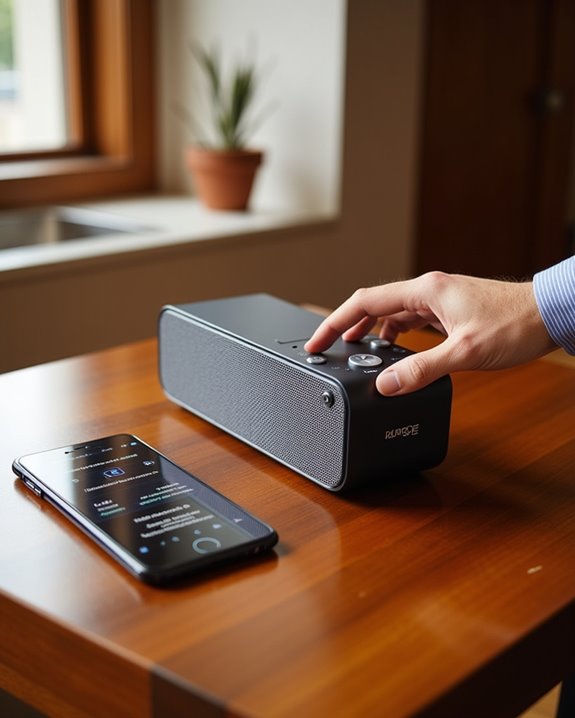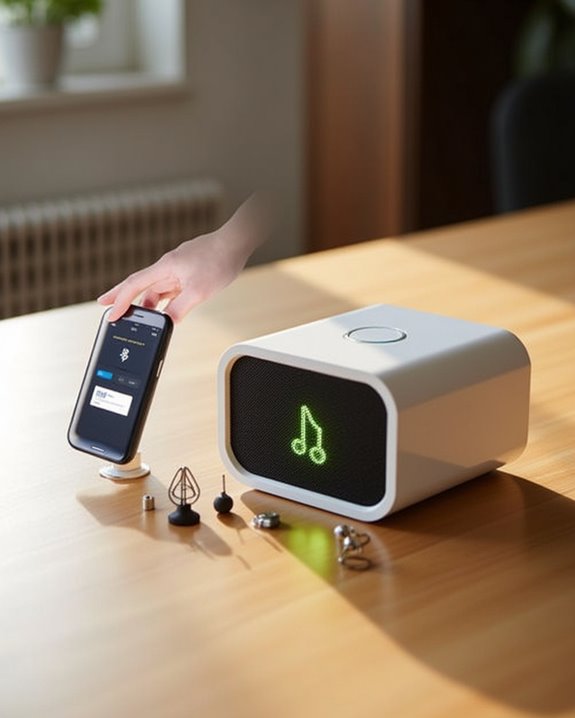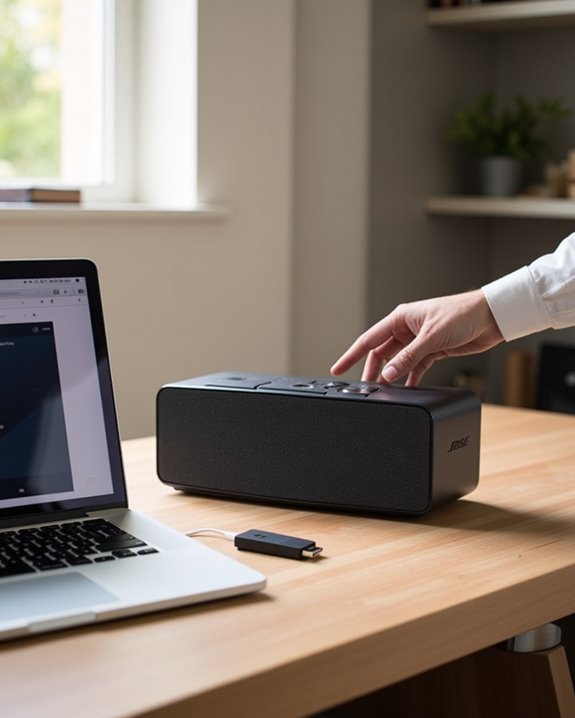To connect a Kitsound Bluetooth speaker, first power on the unit with a sustained press of the multifunction button (MFB), which triggers white LED flashes signaling pairing mode activation. On compatible models, the Play/Pause button may also enable pairing indicated by red and blue LEDs. Activate Bluetooth on the host device, scan for “Kitsound Speaker,” and select it. If prompted, enter the passcode ‘0000’ to authenticate. The connection is confirmed by a solid LED and audio tone, maintaining a stable signal within 30 meters. Additional functionality includes multi-speaker TWS setup. Further technical details and troubleshooting methods provide detailed guidance for effective use.
Key Takeaways
- Press and hold the Multi-Function Button (MFB) until the LED flashes white to activate Bluetooth pairing mode.
- Enable Bluetooth on your device and search for “Kitsound Speaker” in the available devices list.
- Select the speaker from the list and enter passcode ‘0000’ if prompted to complete pairing.
- A solid white or blue LED confirms a successful Bluetooth connection.
- Maintain device within 30 meters for a stable Bluetooth 5.3 connection.
Charging Your Kitsound Bluetooth Speaker
Charging the Kitsound Bluetooth Speaker requires the use of the MicroUSB port, designed to deliver a full recharge typically within four hours, contingent upon the power source’s output capacity. For initial use, a five-hour charge is recommended to optimize battery performance and capacity. Charging while playing music extends the charging duration, as the device draws additional power from the battery. Maintaining battery life involves charging when the battery level falls below 30%, ensuring consistent sound quality and operational efficiency. Additionally, periodic discharge and recharge cycles every three months, regardless of usage frequency, help preserve battery health and longevity. The charging port’s compatibility with standard MicroUSB cables facilitates accessible recharging, making the Bluetooth Speaker a reliable device for continuous audio performance. To maximize the lifespan of your battery, it is advisable to optimize charging cycles by avoiding frequent full discharges and recharges.
Powering On and Activating Pairing Mode
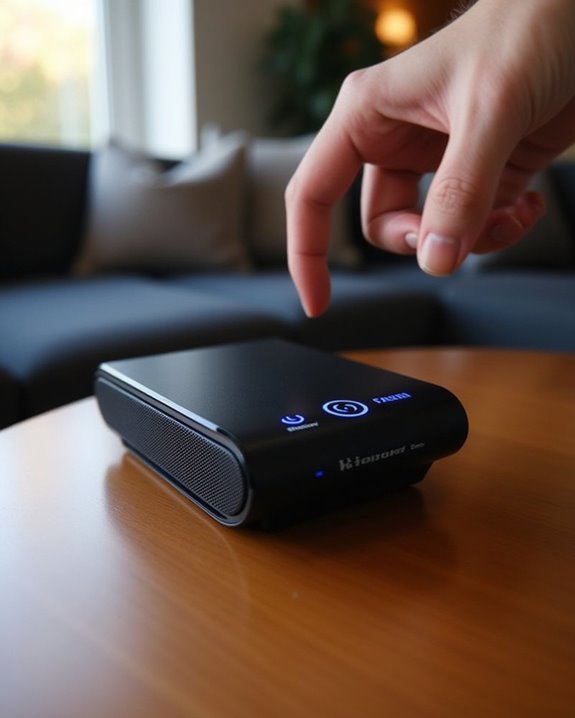
Activating the Kitsound Bluetooth speaker begins with a sustained press of the Multi-Function Button (MFB), which simultaneously powers on the device and initiates pairing mode, indicated by a white LED flashing pattern designed to signal readiness for Bluetooth connectivity. This press and hold action guarantees the speaker enters Bluetooth pairing automatically, streamlining the initial setup process. On select models, pressing the Play/Pause button triggers Bluetooth pairing, with the LED indicator flashing red and blue, signifying active search for devices. Re-pairing also utilizes the long press of the MFB, which powers on the speaker and reactivates pairing mode, confirmed by the LED flashing white. These features combine to provide efficient Bluetooth connectivity management, optimizing user experience through clear visual feedback and straightforward button controls.
Connecting to Your Device via Bluetooth
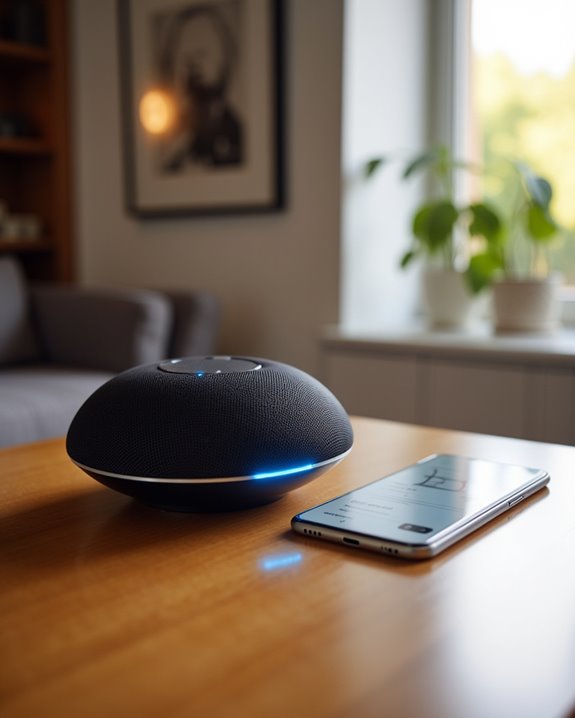
Establishing a Bluetooth connection between the Kitsound speaker and an external device requires enabling the speaker’s pairing mode, typically initiated by a sustained press of the Multi-Function Button (MFB) or Play/Pause button, which triggers an LED indicator to flash in model-specific colors such as red and blue or white. Users should then activate Bluetooth on their iOS, Android, or Windows devices and search for new devices Bluetooth-enabled within range, identifying the speaker by its model name, for example, ‘KS Hive2o.’ Upon selection, if prompted, entering the passcode ‘0000’ guarantees successful pairing. Once connected, the speaker emits an audio tone and the LED will flash white briefly before becoming solid white, confirming the link. The connection remains stable within a 30-meter range, supporting reliable wireless audio transmission for diverse usage scenarios. Understanding Bluetooth range can help ensure optimal performance during your sessions.
Troubleshooting Common Connection Issues
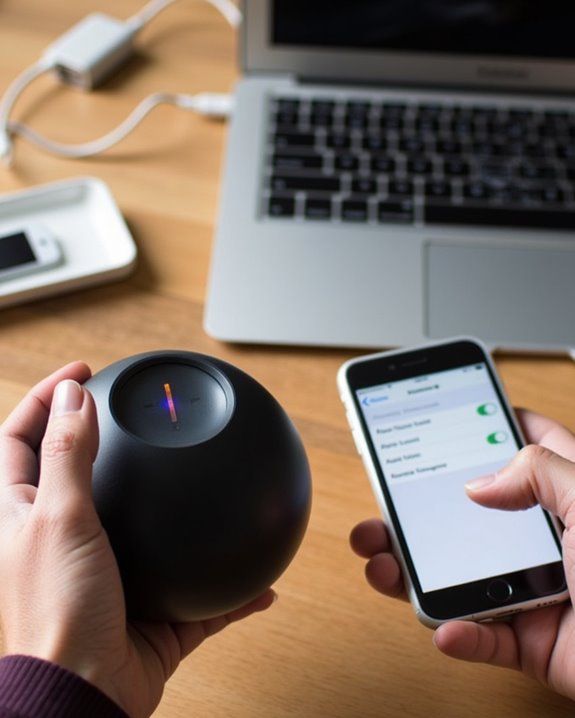
Although the initial connection procedure for the Kitsound Bluetooth speaker is straightforward, users may encounter common issues that impede successful pairing or sustained linkage. To resolve pairing failures, make sure the power button, specifically the multifunction button (MFB), is long pressed until the LED flashes white, confirming pairing mode activation. Users should verify Bluetooth settings on their devices via iOS, Android, or Windows platforms, making sure only one device connects at a time to prevent interference. Maintaining a maximum effective range of 30 meters is critical for stable connections. Bluetooth 5.3 connectivity standard across models ensures enhanced stability and longer range. If a passcode prompt appears, entering ‘0000’ is required for authentication. For persistent connectivity problems, feel free to contact support at [email protected], referencing the manual’s troubleshooting section for expedited assistance.
Using Multiple Speakers for Expanded Sound
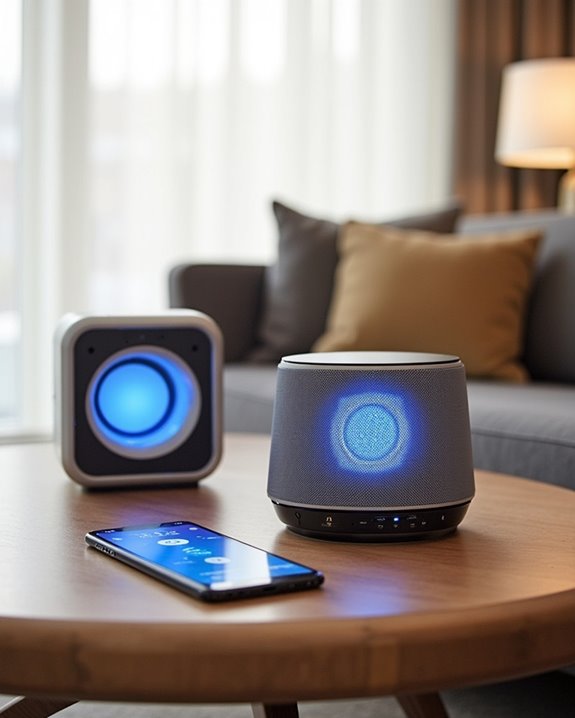
Kitsound speakers support True Wireless Stereo (TWS) pairing by double pressing the Multi-Function Button (MFB) on each unit, allowing one speaker to act as the master connected to the source device while the other functions as a slave synchronized via LED indicators. The Diggit XL model further enables multi-speaker connections within a 30-meter range, providing enhanced audio coverage with dual passive radiators and 2 x 45 mm drivers for immersive middle-range sound. This configuration guarantees synchronized audio output across devices, optimizing performance for larger environments such as outdoor gatherings.
Pairing Multiple Speakers
How can multiple KitSound Bluetooth speakers be paired to create an expanded audio environment? By double pressing the Multi-Function Button (MFB) on each speaker, users activate TWS stereo mode, designating one speaker as master and the other as slave. The master speaker pairs directly with the device using the Bluetooth® word mark technology, while the slave connects via flashing LED indicators, enabling synchronized stereo playback and enhanced sound quality. KitSound’s Diggit XL model supports this multi-speaker connection, ideal for larger spaces with up to 30 meters Bluetooth range. Additional devices can be integrated using the multi-pair button, expanding the audio setup seamlessly. The trademarks owned by Bluetooth guarantee standardized communication protocols, facilitating reliable, immersive surround sound with clear separation and balanced output across paired units.
TWS Stereo Setup
The TWS stereo setup enables the synchronization of two compatible Bluetooth speakers, such as the KS Hive2o model, to deliver spatially separated left and right audio channels, thereby enhancing the listening experience with true wireless stereo sound. To initiate, users double press the Multi-Function Button (MFB) on both speakers; one becomes the master, connecting directly to the Bluetooth device, while the other acts as the slave, linking to the master via flashing LED indicators. Both speakers must be within effective range and free from prior pairings to guarantee seamless connection. This advanced feature utilizes registered trademarks owned by Kitsound, with word mark and logos owned by Bluetooth SIG; the logos are registered trademarks, underscoring compliance with Bluetooth standards and guaranteeing interoperability and quality performance.
Synchronizing Audio Output
Achieving synchronized audio output across multiple Bluetooth speakers involves utilizing True Wireless Stereo (TWS) technology, which enables spatially distributed sound reproduction by designating one unit as the master and additional units as slaves. To synchronize KitSound speakers, users double press the Multi-Function Button (MFB) on each speaker to activate TWS mode; the master speaker then pairs directly with the Bluetooth source device, while the slave connects to the master, indicated by flashing LEDs. The Diggit XL supports linking multiple units within a 30-meter Bluetooth range for expanded sound coverage, ideal for outdoor settings. This pairing process requires a second, separately sold speaker to enable TWS functionality, ensuring stable, simultaneous stereo playback and enhanced audio immersion in group environments.
Adjusting Volume and Playback Controls
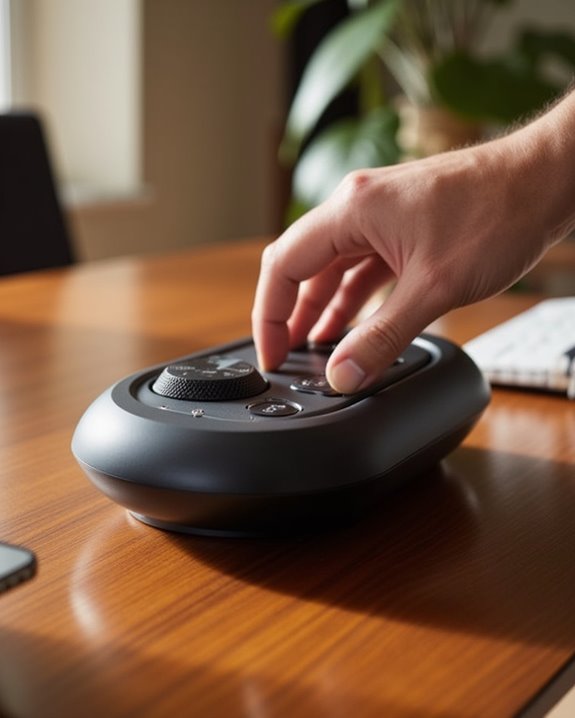
The Kitsound Bluetooth speaker incorporates digital volume controls with precision adjustment capabilities, enabling users to maintain ideal sound levels while minimizing distortion. Its multifunctional buttons allow for seamless playback management, including track skipping through long-press commands and playback toggling via the Play/Pause button. Monitoring LED indicators during operation provides real-time feedback on status, enhancing user control and ensuring a refined audio experience.
Volume Adjustment Tips
How can users optimize audio clarity and control when using the Kitsound Bluetooth speaker? To achieve best sound quality, users should use the speaker’s digital volume control for precise audio level adjustments, ensuring clear output without distortion. Make sure the connected device’s volume remains at or below 95%, as exceeding this threshold may cause audio clipping due to device-specific output variances. The speaker’s volume buttons enable incremental increases or decreases, while long-press functions facilitate track skipping, enhancing user control. Although the Wi-Fi Alliance primarily certifies Wi-Fi devices, understanding connectivity standards assists in managing Bluetooth interference. Monitoring volume adjustments via LED playback indicators provides real-time feedback, ensuring balanced audio output. Accessing the information you need about device compatibility and volume parameters supports an informed, high-quality listening experience.
Playback Control Functions
A thorough understanding of the Kitsound Bluetooth speaker’s playback control functions enhances user interaction by enabling precise management of audio output and media navigation. The speaker features dedicated volume buttons for incremental sound level adjustment, with a recommended device volume cap at 95% to avoid distortion. Long-pressing these buttons activates track skip controls, facilitating navigation to the next or previous track seamlessly. The Play/Pause button doubles as an Answer/End call control, integrating telephony functions efficiently. Visual feedback is provided by LED indicators, such as a slow flashing white light during playback, confirming active status. Users are advised to use voice commands on compatible devices for hands-free control. In maintenance, removing the battery is unnecessary for resetting functions. Note that the Wi-Fi® word mark is unrelated to Bluetooth connectivity but may appear in documentation.
Maintaining Battery Health for Optimal Performance
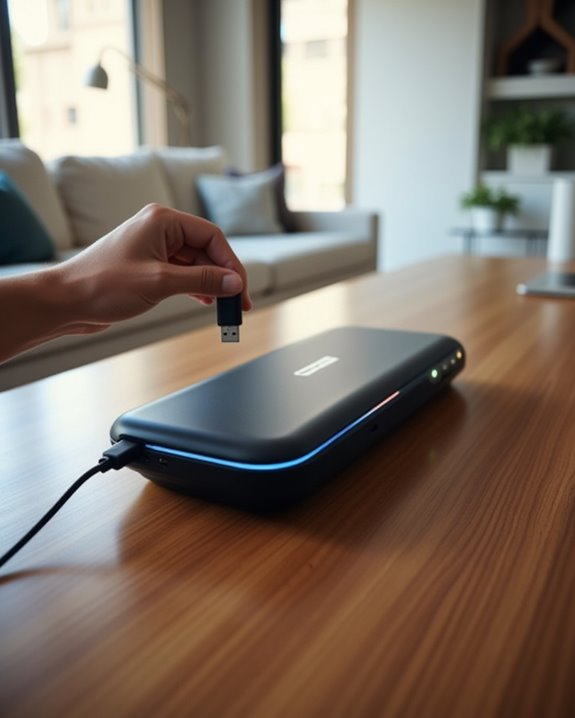
Preserving the Lithium Polymer battery’s longevity in Kitsound Bluetooth speakers requires adherence to specific charging protocols, including avoiding charges beyond 95% capacity to mitigate degradation and scheduling full discharge-recharge cycles every three months to recalibrate battery cells. Ideal battery health is maintained by charging the device for up to five hours initially or when battery levels fall below 30%, ensuring sustained sound quality and performance. It is advised to perform complete discharge and recharge cycles quarterly, regardless of usage, to preserve cell calibration and capacity. Additionally, if the speaker enters battery protection mode after extended non-use, connecting it to power cancels this state, preventing long-term damage. Charging without active playback reduces charging time and promotes efficient energy transfer, contributing to overall battery longevity and operational reliability.
Safety Precautions and Handling Guidelines
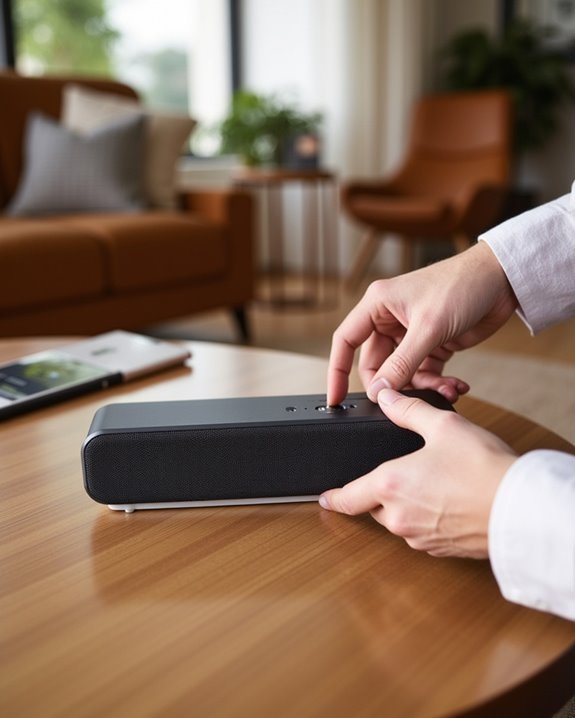
When handling Kitsound Bluetooth speakers, adherence to stringent safety precautions is essential to guarantee device longevity and user safety, particularly due to the presence of Lithium Polymer batteries that require specialized care. Proper disposal of these batteries through recycling facilities prevents environmental harm and complies with regulations, without implying any affiliation with or endorsement by waste management entities. Avoid charging beyond 95% capacity to mitigate overheating risks. Exposure to direct heat sources, such as sunlight or fire, must be avoided to maintain battery integrity. The speaker’s IP67 waterproof rating is guaranteed only when cable connections are removed and protective caps are secured before immersion up to 1 meter for 30 minutes. Usage during charging near water is prohibited, as it compromises device safety. The use of these marks does not imply any affiliation with or endorsement owned by the Wi-Fi Alliance.
Frequently Asked Questions
How Do I Connect My Kitsound Speaker?
The Kitsound speaker offers reliable wireless range and low audio latency, enhancing user experience. Proper speaker maintenance and battery life care guarantee lasting enjoyment, fostering a connected community through seamless, high-quality sound shared among like-minded individuals.
How Do I Put My Bluetooth Speaker in Pairing Mode?
While isolation lingers, connection beckons. A Kitsound speaker enters pairing mode through a Button Hold on the Multi-Function Button, signaled by an Indicator Blinking in a distinct LED Pattern, marking successful Mode Entry and inviting unity.
How to Connect Kitsound Myfm2?
Connecting Kitsound Myfm2 balances connection speed and audio quality through its intuitive user interface. Ideal battery life supports extended use, fostering a shared experience among users who value seamless wireless audio and dependable device interaction.
How to Pair Kitsound Diggit Speakers?
Like dancers finding rhythm, pairing Kitsound Diggit speakers starts by long-pressing the multi-function button. Diggit troubleshooting guarantees firmware compatibility and pairing security, while mindful users consider battery impact, fostering a connected, harmonious audio community.

